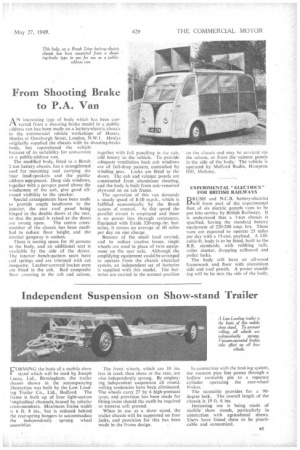From Shooting Brake to P.A. Van
Page 9

If you've noticed an error in this article please click here to report it so we can fix it.
A N interesting type of body which has been converted from a shooting brake model to a publicaddress van has been made on a battery-electric chassis
in the commercial vehicle workshops of Messrs. Henlys at Osnaburgh Street, London, N,W.1. Henlys originally supplied the chassis with its shooting-brake body, but repurchased the vehicle because of its suitability for conversion to a public-address van.
The modified body, fitted to a Brush 2-ton battery chassis, has a strengthened roof for mounting and carrying the four loud-speakers and the publicaddress equipment. Deep side windows, together with a perspex panel above the windscreen of the cab, give good allround visibility to the speaker.
Special arrangements have been made to provide ample headroom to the interior, the rear roof panel being hinged to the double doors at the rear, so that the panel is raised as the doors
are swung open. The centre crossmember of the chassis has been modified to reduce floor height, and the interior gangway is sunken.
There is seating space for 10 persons in the body, and an additional seat is available by the side of the driver. The interior bench-pattern seats have coil springs and are trimmed with cut moquette. Leather-covered bucket seats are fitted in the cab. Red composite floor covering in the cab and saloon, together, with full panelling in the cab, 'add luxury to the vehicle. To provide adequate ventilation both cab windows are of full-drop pattern, Controlled by winding gear. Locks are fitted to the doors. The cab and valence panels are constructed from . aluminium sheeting, and the body is built from oak-veneered plywood on an ash frame.
The operation of this van demands a steady speed of 8-10 m.p.h., which is fulfilled economically by the Brush system of control. At this speed the parallel circuit is employed and there is no power loss through resistances. Equipped with Exide 320-amp.-hr. batteries, it covers an average of 60 miles per day on one charge.
Because of the small load carried, and to reduce tractive losses, single wheels are used in place of twin equipment on the rear axle. Although the amplifying equipment could be arranged to operate from the chassis electrical system, an independent set of batteries is supplied with this model. The batterieS are carried in the normal position EXPERIMENTAL "ELECTRICS" FOR BRITISH RAILWAYS
DI RUSH and N.C.B. battery-electrics will form part of the experimental fleet of six electric parcels vans to be put into service by British Railways. It is understood that a 1-ton chassis is specified, having the standard battery equipment of 220-240 amp. hrs. These vans are expected to operate 25 miles per day with a 15-cwt. payload. A 350cubic-ft. body is to be fitted, built to the B.R. standards, with rubbing rails. roller shutter, dropping tailboard and police locks.
The body will have an all-wood framework and floor with aiaminium side and roof panels. A poster moulding will be let into the side of the body.


























